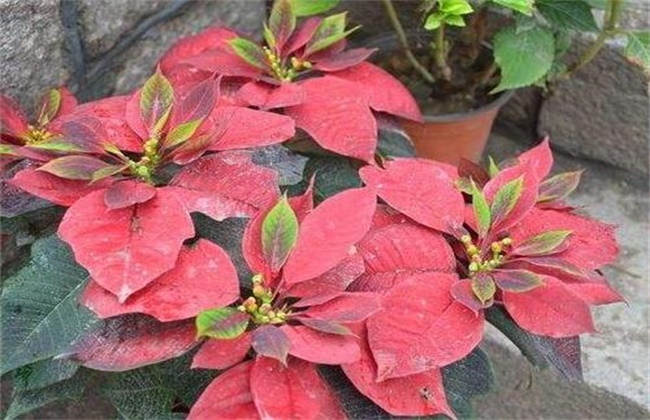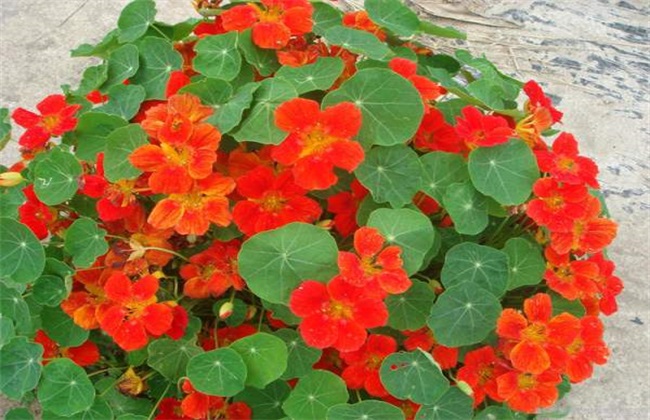The reason why the leaves of poinsettia are not red and its solutions
Poinsettia is a kind of plant with high ornamental value, not only the flowers are red, but also the leaves can turn red, but many people often have the phenomenon that the leaves are not red in the process of breeding. So what should I do if the leaves of poinsettia are not red? With the editor, let's take a look at the reasons why the leaves of poinsettia are not red and the solutions.

1. Time is not up
Poinsettia leaves are not red, a large part of the reason is that the time has not come, although its leaves can turn red, but not all the year round is red, generally need to wait until autumn before its leaves can turn red. So you need to be careful about the leaves and wait patiently until its leaves turn red.
2. Improper watering
Poinsettia likes to grow in moist soil, so it usually needs to be watered frequently, otherwise the plant will be dehydrated, the leaves will not be dehydrated, and the leaves will not turn red in autumn, nor can they be watered too much, otherwise it will lead to rotten roots in the chicken coop, making it difficult for the roots to absorb nutrients, leading to malnutrition and even the death of poinsettia.
Solution: if you water too much, you need to immediately change the basin soil, cut off all the rotten roots, replant new soil, put it in the sun to cause breeding, and master the correct watering method. Generally, spring and autumn need to be watered every 2-4 days, every day in summer and every 7-10 days in winter, so that poinsettia leaves turn red in autumn.
3. Lack of nutrients
A large part of poinsettia leaves are not red is caused by lack of nutrients, if it is not fertilized in time, it will lead to poinsettia malnutrition, so that the leaves can not be red, can not be fertilized too much, otherwise it will cause poinsettia to grow, make the leaves lose color, cause the leaves not to be red, and reduce the ornamental value.
Solution: if poinsettia fertilizes too much, it can directly replace the new soil. Fertilization must be reasonable. Organic fertilizer or liquid fertilizer can be applied every half a month in spring, and liquid fertilizer can be applied every other time in summer, just like in autumn and spring. Poinsettia can grow well without fertilization in winter.
4. Lack of light
Poinsettia is a short-day plant, under sufficient sunlight, it can help photosynthesis and make it more bright. If there is not enough sunlight, it will cause its poor growth, the leaves can not turn red, nor can it be farmed directly in the sun. It burns the leaves and can't turn red.
Solution: if the leaves of poinsettia are not red due to lack of light, you need to give them enough sunlight in time, and you need to put them in astigmatism in spring, summer and autumn. When the temperature gets higher, you need to spray water around to lower the temperature and increase the humidity.
The above is a poinsettia leaf is not red reasons and solutions, hope to help you, want to know more related knowledge, please follow us.
- Prev

How to plant the seeds of Clematis paniculata? The planting method of Clematis paniculata Seeds
How to plant the seeds of Clematis paniculata? The planting method of Clematis paniculata Seeds
- Next

Five advantages of liquid Culture of Edible Fungi
Five advantages of liquid Culture of Edible Fungi
Related
- Fuxing push coffee new agricultural production and marketing class: lack of small-scale processing plants
- Jujube rice field leisure farm deep ploughing Yilan for five years to create a space for organic food and play
- Nongyu Farm-A trial of organic papaya for brave women with advanced technology
- Four points for attention in the prevention and control of diseases and insect pests of edible fungi
- How to add nutrient solution to Edible Fungi
- Is there any good way to control edible fungus mites?
- Open Inoculation Technology of Edible Fungi
- Is there any clever way to use fertilizer for edible fungus in winter?
- What agents are used to kill the pathogens of edible fungi in the mushroom shed?
- Rapid drying of Edible Fungi

